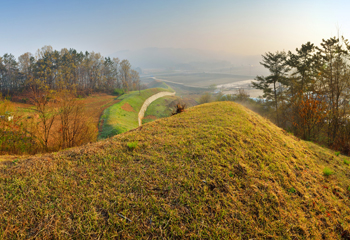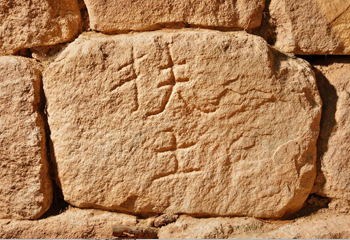Naseong City Wall
Naseong City Wall was constructed to defend the capital, and its original appearance has remained intact. It surrounds the areas of Buyeo. The city wall protected the northern and eastern parts of the capital city, stemming from Busosanseong Fortress. The city wall not only had defensive capabilities, but also served as a symbolic boundary between the inner and outer areas of the capital city. To the west and south of Buyeo, the Geumgang River functioned as a viable natural barrier and its banks served as a continuation of the city wall. In the eastern side of the city, however, artificial facilities were required as there are many flat areas between the mountains.

Archaeological excavation revealed that Naseong City Wall measures 6.3km long and that it is composed of northern and eastern sections. The northern section of the city wall starts from Busosanseong Fortress in the northern area of Buyeo, stretches to the east around Cheongsanseong Fortress, and arrives at Seongmok-ri. The eastern section of the city wall stretches from Seongmok-ri to Yeomchang-ri.
The northern section of the Nasong City Wall lost its defensive function right after the fall of the Baekje, and only a few parts of this section now remained. It is expected to reveal the original shape of the city wall as a whole. The eastern section of the city wall has been conserved in good condition. The archeological excavation conducted over the last 20 years have provided ample information on its construction period, and techniques used for the ramparts, and on its facilities such as gates.
Unlike a mountain fortress, the Naseong City Wall was a unique structure connecting a mountainous area and flat areas to the outer parts of a capital city. Different construction techniques were used for the parts that passed through the mountainous areas and through the low marsh areas.
For the part that passed through the mountainous areas, layers of earth were piled inside the ramparts and a steep slope was created outside the ramparts by cutting into the hillside. A pile of stones measuring about 2m high was also built in order to reinforce the defensive capabilities of the Naseong City Wall.
The parts that passed through the low and swampy areas were built with special construction techniques using plant leaves and trees. Branches with a diameter of 5-6cm and twigs were placed on the foundation layer of the earth along the ramparts. This was done in order to stabilize the foundation layer. Next, a layer of clay soil as thick as 50cm was placed on top of the wood piles and twigs, before another layer of twigs was placed on it again. An excavation survey found part of a peripheral rampart that mea- sured 2m high. It was built by repeatedly piling three layers of leaves, twigs and soil.
The excavation survey on this city wall also discovered traces of wood planks implanted at regular intervals near the ramparts. The size of the planks ranges between 5 and 10cm and the distance between each plank is 50-100cm. The ba
Another distinguishing feature of the construction method used in the low marsh areas was that stone alignments and stone piles were built on the outer part of the foundation structure to strengthen the facility.

As the Geumgang River flows through the north, south, and western parts of Buyeo, the main gate of Naseong City Wall was constructed on the eastern part of Buyeo. The First East Gate Site, which functioned as the main gate, was discovered in the flat area next to the Buyeo Royal Tombs. The width of the main gate measures 9.5m and the gate was built by using rectangular stones.
The East Gate Site No.2 was discovered during an archeological excavation conducted in 2013. This gate site was located 800m to the north of the First East Gate Site, where the city wall turns northwest. With an altitude of 120m, this point commands a fine view of the downtown area of Buyeo and of Mireuksan Mountain in Iksan. Archeological investigations of the gate sites found several fragments of roof tiles and pillar holes, suggesting that the sites were once occupied by buildings such as gate towers.










